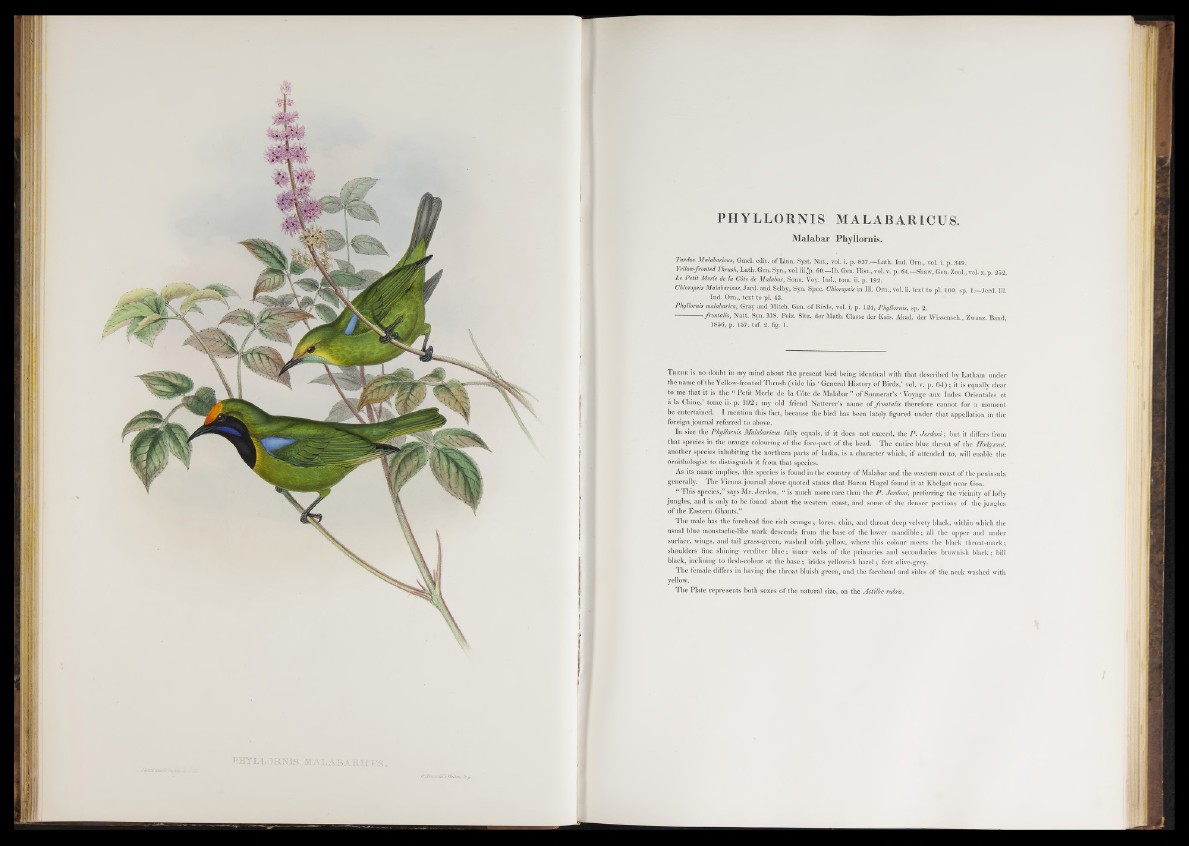
PmTLLOiRBIS MAiABARICUS,
PHYLLORNIS MALABARICUS.
Malabar Phyllornis.
Turdus Malabaricus, Gmel. edit, o f Linn. S y st Nat., vol. i. p. 837.—Lath. Ind. Om., vol. i. p. 3 4 9 .
Yellow-fronted Thrush, Lath. Gen. Syn., vol. iii/p. 60.—Ib. Gen. H ist., vol. v. p. 64.—Shaw, Gen. Zool., vol. x. p. 252.
Le Petit Merle de la Cote de Malabar, Sonn. Yoy. Ind., tom. ii. p. 192.
Chloropsis Malabaricus, Jard. and Selby, Syn. Spec. Chloropsis in 111. Om., vol. ii. text to pi. 100. sp. 1. Jerd. 111.
Ind. Om., text to pi. 43.
Phyllornis malabarica, Gray and Mitch. Gen. o f Birds, vol. i. p. 124, Phyllornis, sp. 2.
--------------frontalis, Natt. Syn. MS. Pelz. Sitz. der Math. Classe der Kais. Akad. der Wissensch., Zwanz. Band,
1866, p. 157. taf. 2. fig. 1.
T h e r e is no doubt in my mind about the present bird being identical with that described by Latham under
the name o f the Yellow-fronted Thrush (vide his ‘ General History of Birds,’ vol. v. p. 6 4 ) ; it is equally clear
to me that it is the “ Petit Merle de la Cote de Malabar” of Sonnerat’s ‘Voyage aux Indes Orientales et
a la Chine,’ tome ii. p. 192; my old friend Natterer’s name o f frontalis therefore cannot for a moment
be entertained. I mention this fact, because the bird has been lately figured under that appellation in the
foreign journal referred to above.
In size the Phyllornis Malabaricus. fully equals, if it does not exceed, the P . Jerdoni; but it differs from
th at species in the orange colouring of the fore-part of the head. The entire blue throat of the Hodgsoni,
another species inhabiting the northern parts of India, is a character which, if attended to, will enable the
ornithologist to distinguish it from that species.
As its name implies, this species is found in the country of Malabar and the western coast o f the peninsula
generally. The Vienna journal above quoted states that Baron Hugel found it a t Khelgat near Goa.
“ This species,” says M r. Jerdon, “ is much more rare than the P . Jerdoni, preferring the vicinity of lofty
jungles, and is only to be found about the western coast, and some of the denser portions of the jungles
of the Eastern Ghauts.”
The male has the forehead fine rich orange; lores, chin, and throat deep velvety black, within which the
usual blue moustache-like mark descends irom the base o f the lower mandible; all the upper and under
surface, wings, and tail grass-green, washed with yellow, where this colour meets the black throat-mark;
shoulders fine shining verditer b lu e ; inner webs of the primaries and secondaries brownish black; bill
black, inclining to flesh-colour a t the base ; irides yellowish hazel; feet olive-grey.
The female differs in having the throat bluish green, and the forehead and sides of the neck washed with
yellow.
The Plate represents both sexes o f the natural size, on the Astilbe rubra.